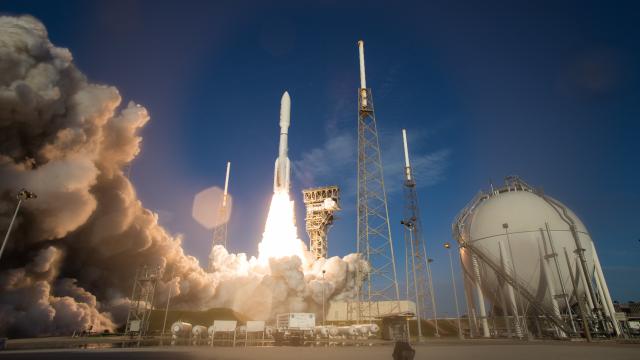True to this agonising year that is 2020, yesterday’s launch of NASA’s Perseverance Mars rover was not without problems.
As scheduled, a ULA Atlas V rocket carrying the Perseverance rover and Ingenuity helicopter lifted off from Cape Canaveral Air Force Station in Florida yesterday morning. Now in space, the Mars 2020 mission is expected to reach the Red Planet in February 2021.
Everything seemed picture perfect, but NASA said a couple of glitchy things happened during the launch, neither of which are expected to jeopardise the mission.
As the Atlas V sped toward space, telemetry signals sent to ground-based antennas failed to receive the incoming data. The spacecraft was apparently too close to NASA’s Deep Space Network — a system of ground-based antennas designed to communicate to deep space — causing a signal saturation at the ground receivers, which prevented proper receipt of the telemetry data, according to NASA.
“This is a known issue that we have encountered on other planetary missions, including during the launch of NASA’s Curiosity rover in 2011,” explained Matt Wallace, deputy project manager for the Mars 2020 mission, in a NASA statement. “The Perseverance team worked through prepared mitigation strategies that included detuning the receivers and pointing the antennas slightly off-target from the spacecraft to bring the signal within an acceptable range. We are now in lock on telemetry after taking these actions.”
I now have good signal strength with my team back on Earth. They’re tracking my location and will keep talking to me as I cruise to Mars. https://t.co/q8GY0wfue5 #CountdownToMars https://t.co/9JZeseTC1M
— NASA’s Perseverance Mars Rover (@NASAPersevere) July 30, 2020
OK, so no big deal, but the second issue, though also not serious, is still a work in progress: The spacecraft is currently in safe mode following a temperature anomaly.
The system uses a liquid freon loop, in which heat from the core of the spacecraft is transported to radiators on the cruise stage, the part of the vehicle that’s delivering the rover to Mars. A sizable temperature gap between the warm inlet to the radiators and the cooler outlet from the radiators led to the precautionary software mode.
“As the spacecraft entered into Earth’s shadow, the Sun was temporarily blocked by Earth, and the outlet temperature dropped,” said Wallace. “This caused the difference between the warm inlet and cooler outlet to increase. This transient differential tripped an alarm and caused the spacecraft to transition into the standby mode known as ‘safe mode.’”
Calling it a “transient event,” Wallace said the triggering of safe mode “during this transitional phase is not problematic for Mars 2020.”
NASA says it has a handle on the problem, and mission controllers are now performing the requisite steps to transition the spacecraft back into normal cruise mode.
Phew. Glad these are minor issues. A major setback for the Mars 2020 mission is exactly what we don’t need right now.
